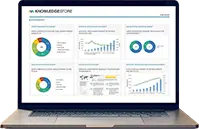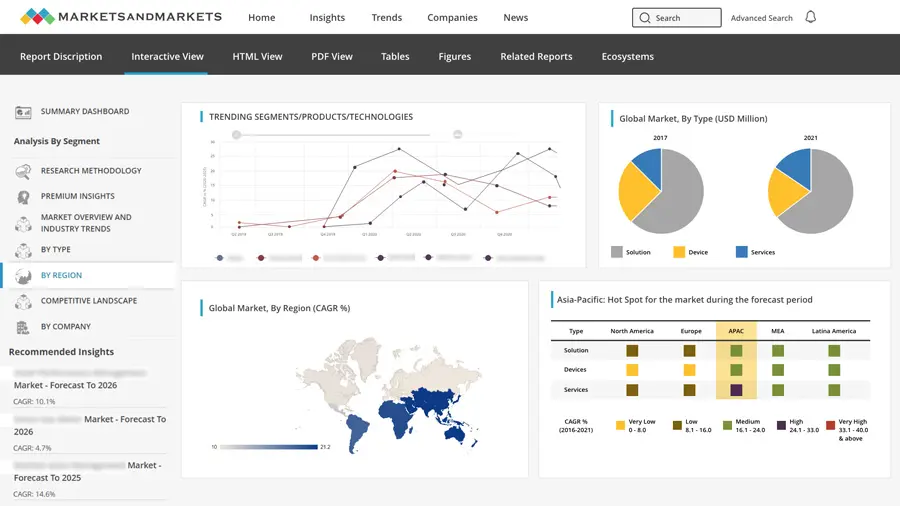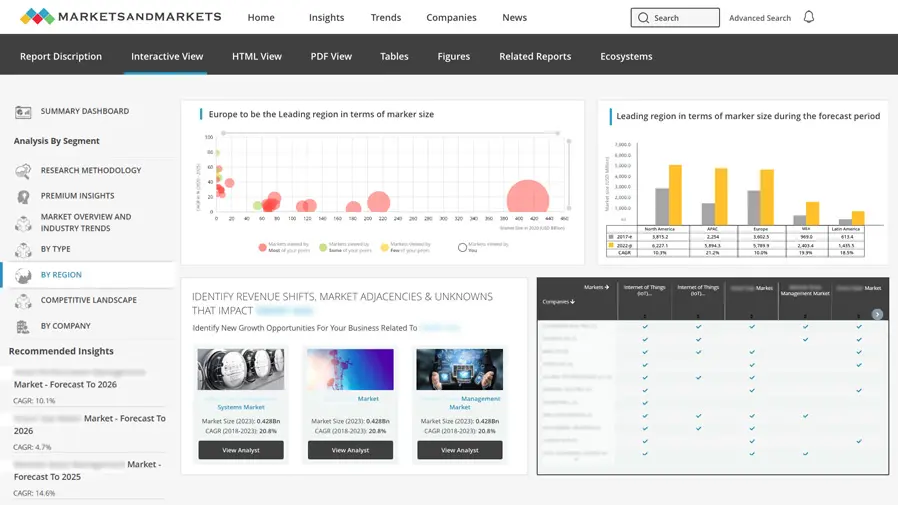Open RAN Automation Market - Global Forecast to 2030
The Open RAN Automation Market is estimated to be worth USD XX billion in 2024 and is projected to reach USD XX billion by 2030 at a Compound Annual Growth Rate (CAGR) of XX.X % during the same period. The RAN automation market traces its roots back to the beginning of the LTE era when Self-Organizing Network (SON) technology was introduced to reduce cellular network complexity through self-configuration, self-optimization, and self-healing. These deficiencies in SON together with the cellular industry's new wave of open interfaces, common information models, virtualization, and software-driven networking drive a transition to Open RAN automation with standards-based components specifically the Near-RT (Real-Time) and Non-RT RICs (RAN Intelligent Controllers), SMO (Service Management & Orchestration) framework, xApps (Extended Applications), and rApps (RAN Applications), which enable greater levels of RAN programmability and automation.

To know about the assumptions considered for the study, Request for Free Sample Report

USE CASES OF AI/GEN AI IN OPEN RAN AUTOMATION MARKET
Generative AI can significantly enhance Open RAN automation by enabling advanced capabilities for network optimization, simulation, and innovation. It can create synthetic datasets to simulate various network conditions, helping operators design optimal configurations without relying on expensive real-world trials. Using generative models can help to optimize RAN parameters in real-time based on traffic patterns and user density. Models can help simulate potential network failures and identify anomalies in RAN operations before they impact performance

Global Open RAN Automation Market Dynamics
Driver: Multi-vendor ecosystem
Open RAN encourages innovation in hardware and software solutions by allowing multiple vendors to contribute. It creates a competitive environment where it reduces costs and promotes quality and performance in the automation tools and technologies being used. Open RAN's disaggregated architecture allows the development of customized and efficient networks. With operators not locked in with a single vendor, operators can more easily change and upgrade network components with reduced costs. A multi-vendor approach allows operators to negotiate competitive pricing for capital and operational expenditures. Also, through a multi-vendor ecosystem, it will be able to speed up the integration of new technology like AI/ML driven automation, edge computing, or energy-efficient solutions into the mainstream market
Restraint: Interoperability Issues
Multi-vendor hardware and software components are common in Open RAN automation and often lack a unified standard, causing interoperability issues. Because of this, the vendors may implement the Open RAN specifications differently, leading to compatibility issues and inefficiencies in automation processes. High complexity and costs in deploying systems are involved due to extensive testing required to ensure smooth communication and coordination among diverse systems. Inconsistent configurations or proprietary technologies complicate network management and optimization. These issues are a bottleneck for the large-scale adoption of Open RAN and highlight the necessity for standardized protocols, robust integration tools, and collaboration between vendors to handle these challenges most efficiently.
Opportunity: Green networking
Global sustainability is also a vital green networking component of Open RAN automation as it diminishes the cost of operation. AI-driven automation of the equipment ensures optimized energy consumption based on variations in traffic patterns, resulting in emissions diminution. Another related sustainability factor in the architecture is disaggregated architecture that easily integrates hardware and software related to sustainability and energy efficiency. Automation also helps in the optimization of resources and predictive maintenance, thus helping save energy. With 5G and beyond evolution, green networking shall support scalable operations that are environment-friendly; concern for the environment will be addressed while boosting efficiency and fulfillment of regulatory requirements for sustainable telecom infrastructure.
Challenge: Regulatory uncertainty
The main challenge for Open RAN automation is regulatory uncertainty. Shifting policies on spectrum allocation, network security, and multi-vendor interoperability create complex compliance requirements. Regional differences in standards make it challenging to achieve global consistency in deployments. Ambiguities around AI/ML integration in automation, data privacy, and security concerns further complicate the challenge. All these factors delay investments and stifle innovation, which slows market growth. The step above requires regulators, industry participants, and vendors to cooperate and make clear, harmonized policies that would instill confidence, stimulate innovation, and encourage wide adoption of Open RAN automation solutions.
Ecosystem of Open RAN Automation Market
The prominent players in the Open RAN Automation market include Nokia (Finland), Ericsson (Sweden), and Microsoft (US). These companies have been operating in the market for several years and possess a diversified product portfolio, state-of-the-art technologies, and a well-established geographic footprint. These companies are rigorously working towards the research & development of Open RAN Automation infrastructure.

To know about the assumptions considered for the study, download the pdf brochure
“The software segment is expected to hold the largest market size during the forecast period.”
Software is crucial for network orchestration, AI-driven optimization, predictive maintenance, and real-time analytics in Open RAN automation. They are driven by the increasing reliance on intelligent automation and network management tools. The growing need for intelligent network management and self-optimizing networks (SON) further accelerates the demand for automation software. As Open RAN focuses on software-defined networks (SDN) and network functions virtualization (NFV), software plays a major role in enabling flexibility and scalability. Software tools that help integrate multi-vendor components, automate configuration, and manage RAN performance are essential for effective Open RAN automation.
“Enterprises segment is expected to witness the fastest growth rate during the forecast period.”
Enterprises, including manufacturing, healthcare, logistics, and smart cities, increasingly adopt private 5G networks, leveraging Open RAN automation for customized, cost-efficient, and scalable solutions. The flexibility of Open RAN allows enterprises to build tailored networks, driving rapid adoption. Enterprises are prioritizing digital transformation, adopting advanced technologies such as IoT, edge computing, and AI, all of which benefit from Open RAN automation’s dynamic resource management and operational efficiency. Open RAN’s disaggregated architecture and automation capabilities offer significant cost savings for enterprises, making it an attractive alternative to traditional network solutions. Enterprises, especially in tech-forward industries, often show a quicker adoption curve for emerging technologies than service providers, who are more cautious due to legacy system dependencies.
“North America is expected to hold the largest market share during the forecast period.“
Open RAN automation is critical in North America due to the region's focus on advancing 5G deployments and maintaining technological leadership. It enables cost-efficient network operations by automating resource optimization, fault detection, and performance management. Open RAN automation supports multi-vendor ecosystems, reducing reliance on traditional vendors and fostering innovation. It aligns with North America's drive for network security and flexibility, addressing national security concerns by diversifying the telecom supply chain. Additionally, automation enhances network scalability to meet the increasing demand for high-speed connectivity in industries like smart cities, autonomous vehicles, and private 5G networks, fueling regional growth.

Key Market Players
Nokia (Finland), Ericsson (Sweden), Rakuten (Japan), Broadcom (US), IBM (US), Mavenir (US), Google (US), Tech Mahindra (India), Qualcomm (US), Juniper Networks (US), Parallel Wireless (US), Netcracker (US), Viettel (Vietnam), Accenture (Ireland), and Capgemini (France). These players have adopted various growth strategies, such as partnerships, agreements & collaborations, product launches & enhancements, and acquisitions to expand their Open RAN Automation market footprint.
Recent Developments:
- In November 2024, Ericsson and Orange Belgium completed the 5G slicing automation project
- In November 2024, Nokia was awarded more than 3,000 sites by Deutsche Telekom AG to support the operator's multi-vendor Open RAN network scale-up in Germany.
- In October 2024, Mavenir, the cloud-native network infrastructure provider collaborated with Intel to pioneer innovative AI/ML Open RAN solutions to improve challenging cell edge problems that impact user Quality of Experience.
- In February 2024, Samsung Electronics Co., Ltd., Juniper Networks, and Wind River collaborated on a virtual cell site router (vCSR) to allow service providers to operate their networks with end-to-end virtualization.
- In September 2023, Ericsson announced an expansion of its successful and long-standing partnership with Google Cloud to develop an Ericsson Cloud RAN solution on Google Distributed Cloud (GDC) that offers integrated automation and orchestration and leverages AI/ML for additional communications service providers (CSP) benefits.
Frequently Asked Questions (FAQ):
What are the opportunities in the Open RAN Automation market?
What is the definition of the Open RAN Automation market?
Which region is expected to have the largest market share in the Open RAN Automation market?
What is the market size of the Open RAN Automation market?
Who are the key players operating in the Open RAN Automation market?
















Growth opportunities and latent adjacency in Open RAN Automation Market